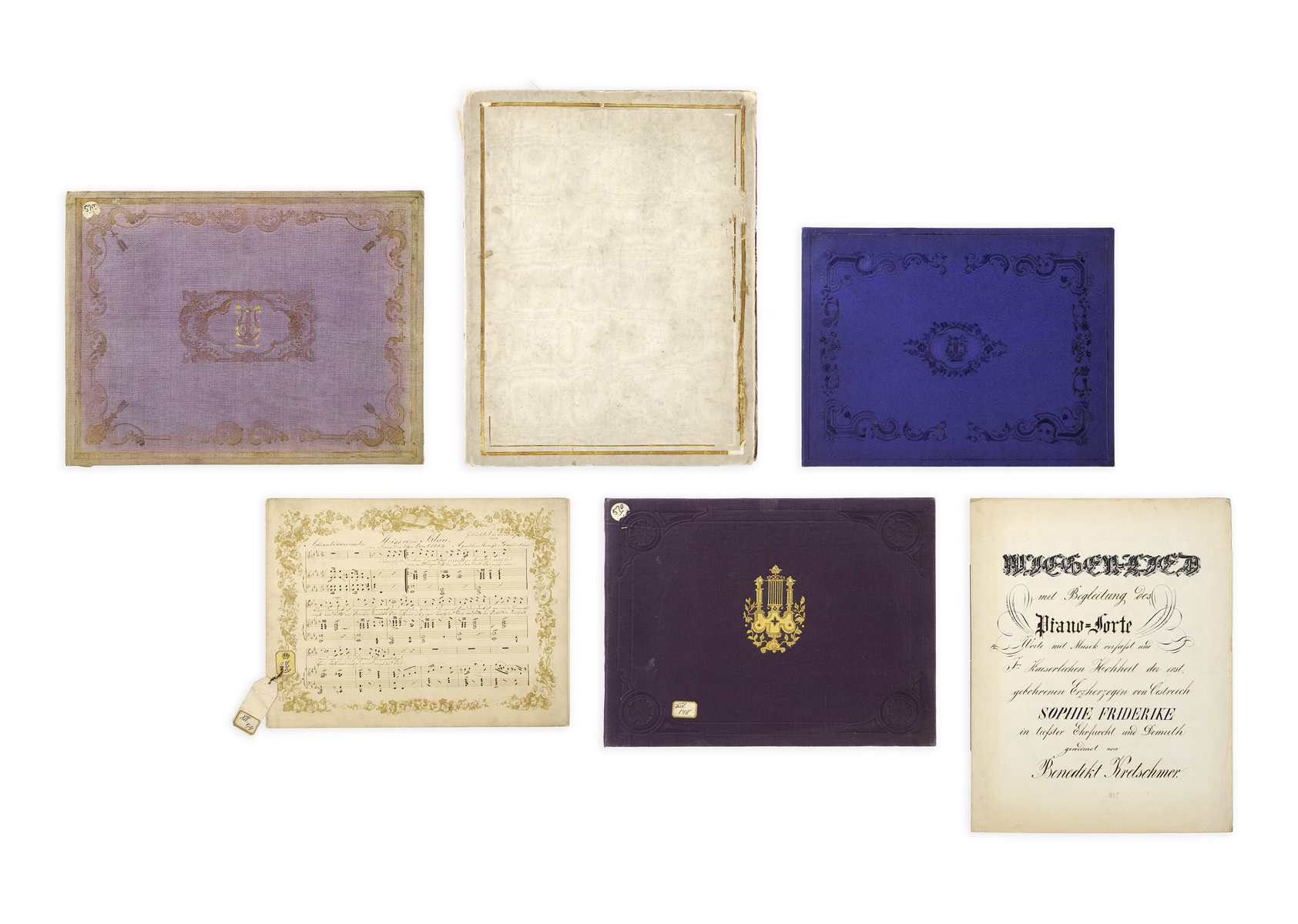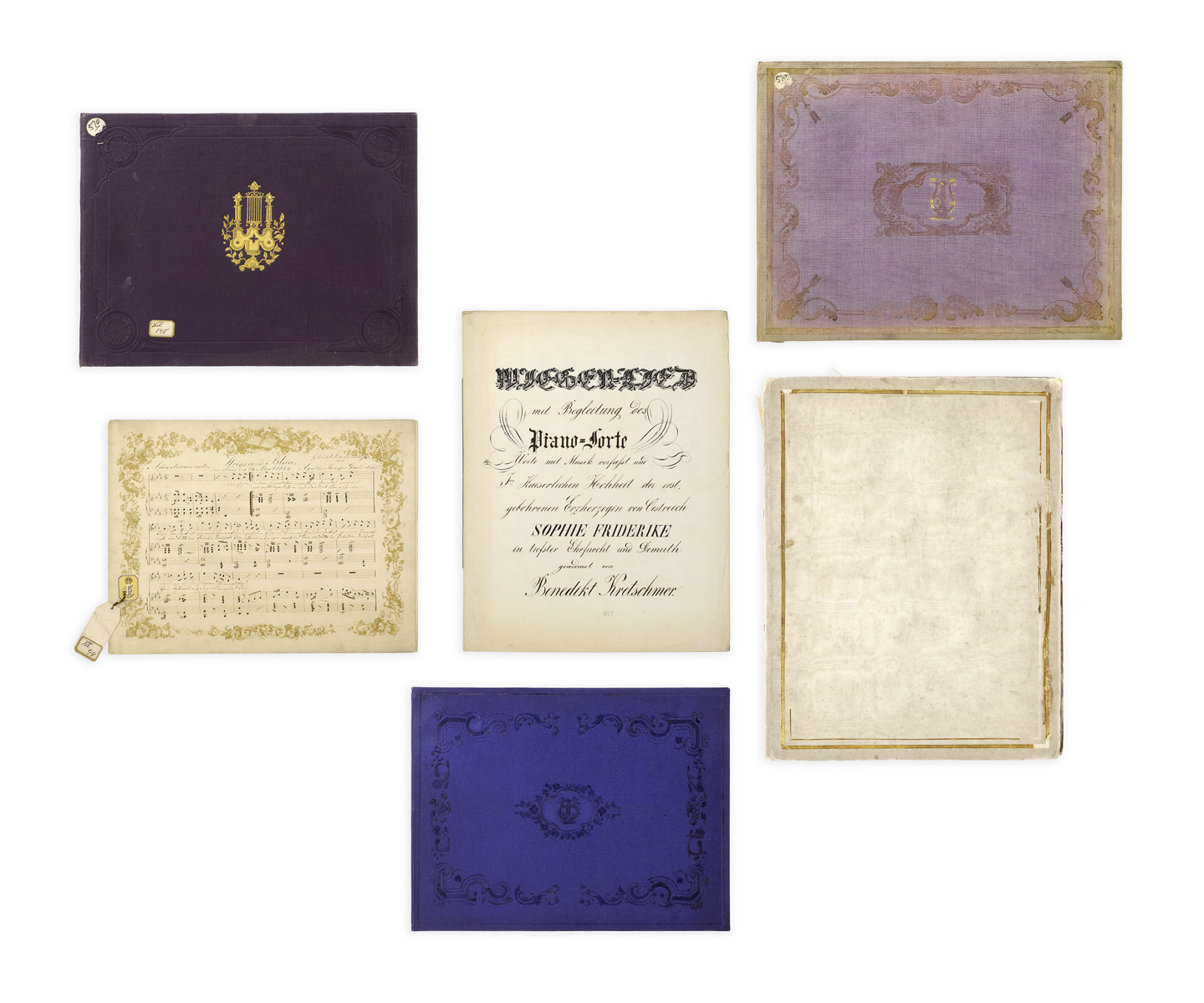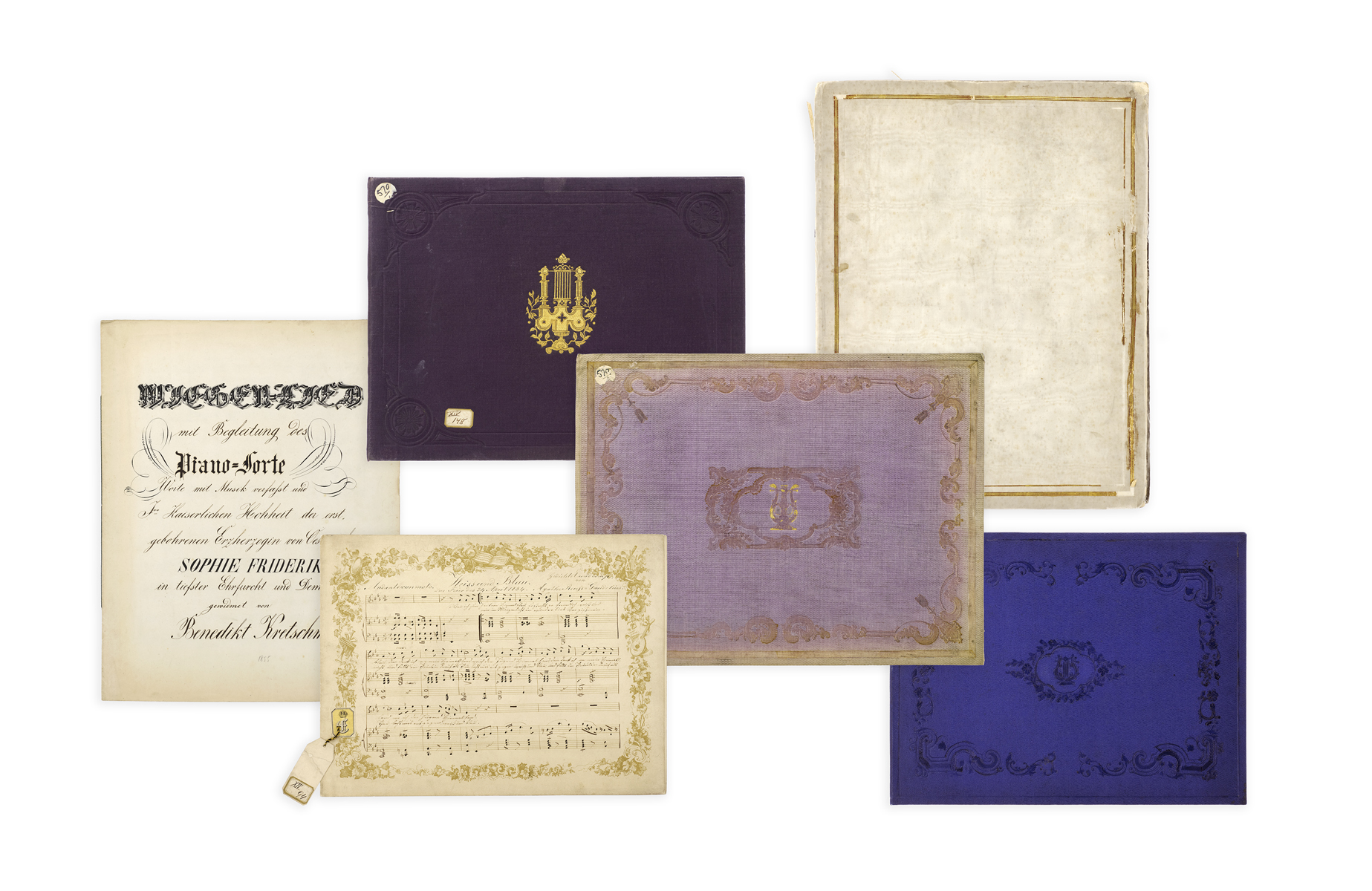


MUSIC FOR SISI
ELISABETH, Empress of Austria.
A collection of six manuscript scores from the library of Elisabeth (‘Sisi’), Empress of Austria, four of which dedicated to her.
1850–60s.

Added to your basket:
A collection of six manuscript scores from the library of Elisabeth (‘Sisi’), Empress of Austria, four of which dedicated to her.
Elizabeth Amalie Eugenie of Bavaria (1837–1898), or ‘Sisi’, married Emperor Franz Joseph of Austria at the age of 16, on 24 April 1854. Her first child, a daughter, was born 11 months later but died as an infant (see below), and a male heir had to wait until the birth of Crown Prince Rudolf in 1858 – he later killed himself and his lover in a murder-suicide pact at Mayerling in 1889 (subject of Kenneth MacMillan’s ballet of 1978). Famed for her exceptionally long hair, and the extreme thinness of her waist – a product of fasting cures, and tight-lacing – Sisi had romantic poetic instincts and a tendency towards melancholy. Isolation at court and recurring health troubles increasingly took her for cures at Corfu and Bad Kissingen (see below). In 1898, while travelling incognito in Switzerland, she was assassinated by an Italian anarchist. A museum devoted to her tragic life is in the Hofburg in Vienna, and she has garnered much recent attention on screen from the series The Empress and the film Corsage.
Comprising:
HEINEFETTER, Wilhelm. Mein Glück. Lied für Tenor mit Pianoforte-Begleitung … Op. 3. [1850s]. Oblong folio, pp. 6; contemporary mauve cloth, blocked in blind and gilt (gilding faded, edges sunned); cypher and index tag of Empress Elizabeth. (XIV 24).
HEINEFETTER, Wilhelm. Zwei Tänze. 1. Polka, 2. Polka-Mazurka für Clavier. [1860s?]. Oblong folio, pp. [2 (dedication and blank)], [1 (title)], [10], [1 (blank)], music within a passepartout border (by Jos. Scholz, Mainz) printed in purple; in contemporary dark blue cloth, blocked in black and blind; cypher and index tag of Empress Elizabeth (XIV 31). Dedication to title-page ‘zur Erinnerung an Kissingen’.
Wilhelm Heinefetter (1835?–1934), was a Kapellmeister from a family of singers; a number of his compositions were published by Schott from 1860. As Konzertmeister of the orchestra of Mainz, he also led the spa orchestra at Bad Kissingen during the summer months from 1855 until the late 1860s. Elisabeth went on cures there regularly from 1862, and the second work here seems to have been dedicated to her as a memento of a visit.
KEMPTER, Karl. Grosse Militair-Messe für 1 Flöte, 5 Clarinetten, 2 Oboen, 4 Hörner, 3 Flügelhörner, 4 Trompetten, 2 Fagott, 1 Euphonium, 3 Posaunen, 1 Ophiglaid [ophicleide], 1 Bombarden und Pauken … Opus 50. [1855?] Large 4to, ff., [1 (title)], [1 (blank)], [21 (music)]; in worn contemporary white silk over boards, onlaid gilt paper borders (chipped), spine defective, edges frayed; cypher and index tab of Empress Elizabeth to front endpaper (XIV 9); laid in loose is an unrelated letter to Kempter from Johann Mayer, Priester des ritterlichen Kreuzherrn-Ordens mit dem rothen Sterne (a Bohemian order), dated 11 March 1851, discussing music.
Karl Kempter (1819–71), was organist of Augsburg cathedral from 1839 for 25 years, and then the cathedral conductor from 1865. Probably the best known among this group of composers, his work is still performed, particularly the Great Pastoral Mass in G Minor (op. 24, 1851).
KRETSCHMER, Benedikt. Wiegenlied mit Begleitung des Piano-Forte. Worte mit Musik verfasst und Ire Kaiserlichen Hohheit der erst gebohrenen Erzherzogin von Oestreich Sophie Friderike in tiefster Ehrfurcht und Demuth gewidmet … [1855]. 4to, ff. 4, with a part-printed calligraphic title-page, four pages of music and final blank; stitched with green thread; with an autograph letter from the composer to the Empress dedicating the work, dated 18 March 1855. ‘O! That I might obtain through Her high influence, that the fair imperial child were lulled just once into sweet sleep by this song …’ (our translation).
Archduchess Sophie had been born on 5 March 1855 but would die as an infant in 1857. Benedikt Kretschmer’s letter proclaims him a music-teacher in Mährisch-Schönberg in Moravia (now Šumperk, Czech Republic), but he is otherwise unknown.
MAYRHOFER, Steffen. Christnacht Träume. Salon Piece componirt für Piano-Forte. [after 1867]. Oblong folio, ff. [1 (title and dedication)], [2 (music)], within a passepartout border printed in blue (the same design as on Reuss-Gaudelius below); stitched into a dark purple portfolio, blocked in blind and gilt; index label of Empress Elizabeth (XIV 148). Dedication on title-page to Empress Elizabeth as Queen of Hungary.
Steffen Mayrhofer describes himself on the title-page as ‘Capellmeister u. Violin Concertist’, as well as a recipient of the ‘Orden für Kunst u. Wissenschaft’. He was largely active in Vienna.
REUSS-GAUDELIUS, Agathe [Anna?]. Weiss und Blau. Zur Feier des 24 April 1854. Two copies, oblong folio, each three pages of music on a bifolium, within a passepartout border printed in gold; cypher and index tab of Empress Elizabeth to first page (XIV 94).
Reuss-Gaudelius (1818–61) was a well-known actress and soprano. The present work, ‘gedichtet und componirt’ by her, was written in honour of Elisabeth’s marriage to Franz Joseph, and has been supplied in two copies, presumably one each for the pianist and singer. Sisi was herself a poet manqué but we have been unable to determine if she sang. We cannot trace another composition by Reuss-Gaudelius.

